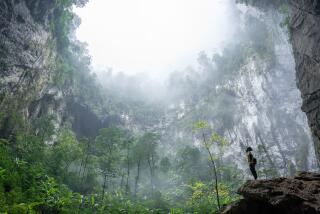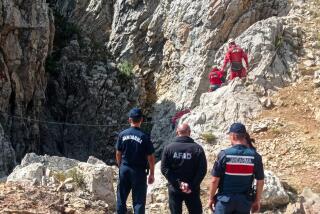Fortress Thrives in Cave
- Share via
POSTOJNA, Yugoslavia — “Do you think there are still marauders in these hills?” asked my daughter, Lisa, from the back seat of our rented car.
We had just taken a tour through the marvelous caves at Postojna and were making our way to a nearby attraction, the curious castle at Predjamski Grad, about five miles west of Postojna.
My wife, Mary, and I had been here before, and we wanted to share the romance of this place with our daughter. I had been teling her about some of the rich traditions and legends associated with Slovenia.
“I think they’ve gotten that problem under control,” I said, although as we drove across the serene hillsides I could imagine a notorious brigand and his band of outlaws appearing from over the next rise, or lying in wait in one of the many forested glens, ready to demand heavy toll for the privilege of traveling through his area.
I explained to her that getting the problem under control had not been easy because of the location of a particular brigand’s castle.
A Lonely Region
Sometime in the Middle Ages a castle was built in a cave in the lonely region of Notranjska.
In the 14th Century it came into the hands of the proud and aggressive Leuger family. Erasmus Leuger, liege lord of the area in the last half of the 15th Century, provoked the emperor, Fredrick III, by killing a kinsman.
The emperor was furious with Erasmus, not only because of the killing but because Erasmus was having an adverse effect on commerce. His band would swoop down on merchant caravans making their way from Lubjana to Trieste, make their demands or take what they wished, and return to their craggy fortress. It was that fortress we were about to visit.
When the emperor could tolerate no more, he ordered the commander of Trieste to take the robber baron dead or alive. Leuger retreated to his rocky aerie, which could be reached only by a drawbridge over a 200-foot chasm.
In the winter of 1483-84 the commander and his army vainly besieged the castle, which was found to be unconquerable; the robber and his men continued to obtain provisions through a secret passage leading from the cave to the forest floor on top of the mountain.
Leuger withstood the siege for more than a year, occasionally mocking the besiegers by throwing meat, fish and cherries down on them.
The lord of the cave fortress could have held out indefinitely, but one of his servants was bribed into revealing to the soldiers below a place Leuger visited each evening before retiring.
A Fatal Cannonade
The servant agreed to place a candle at that spot when it was occupied by Leuger. Upon seeing the light, the besiegers bombarded the place with stone cannonballs, killing Leuger, demoralizing his men, and persuading them to open the gate for the emperor’s army.
As we pulled into the parking lot and looked up the small canyon toward the castle site, our daughter was anxious to go exploring. I reminded her that what we saw from that vantage point--a multifaceted fortress jutting out of a gigantic opening in the mountain--was not Leuger’s stronghold.
That lay behind the castle, which was now so obvious. Indeed, for 100 years after it fell to the emperor’s army, the original castle lay forgotten in its rocky wall.
Then in 1570, beneath the old cave castle, Johan Kobenzl, an imperial diplomat, built a Renaissance castle, which is what presents itself today. Two dates, 1570 and 1583, on the entrance portal, testify to that latter period of construction.
The castle subsequently passed through the hands of other powerful families, one of whom sealed up the secret passage because thieves were entering the castle and stealing precious objects.
Eventually the castle came into the hands of the national government and is under the administration of the management of the Postojna Caves.
Paying a small fee at the entrance, we crossed over the permanent bridge, which has replaced the drawbridge.
Just inside the gate is a collection of stone cannonballs, like the one that reputedly killed Leuger.
Occupied in Stone Age
Each of the castle’s many rooms contain furnishings and objects that were used at various times. Neolithic tools and weapons show that the cave was occupied in the Stone Age. Another room has artifacts indicating occupation by Romans. Still other rooms are filled with weapons, suits of armor and hunting trophies left by its medieval residents.
Of special interest is an exhibit of weapons and memorabilia from World War II when the castle housed a secret printing press used by resistance fighters.
Climbing even higher, sometimes by stone steps cut into the rock, we explored the cave fortress.
At each level the views of the valley became more splendid. Behind the castle is a network of caves, most of them formed by an underground river.
Returning to the car, we visited a small church dating from the 15th Century. Tradition says that Leuger is buried under a linden tree near the church.
The castle is open every day during daylight hours and may be visited for a fee of about $2.
To find the castle, drive west from Postojna to the village of Veliki Otok and follow the signs reading: “Predjamski Grad.”
For more information, contact Yugoslavia National Tourist Office, 630 Fifth Ave., Suite 280, New York 10111.
More to Read
Sign up for Essential California
The most important California stories and recommendations in your inbox every morning.
You may occasionally receive promotional content from the Los Angeles Times.













